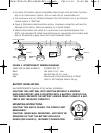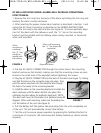WHAT TO DO WHEN THE ALARM SOUNDS
• Alert small children in the home.
• Leave immediately by your escape plan. Every second counts, so don’t waste
time getting dressed or picking up valuables.
• In leaving, don’t open any inside door without first feeling its surface. If hot,
or if you see smoke seeping through cracks, don’t open that door! Instead,
use your alternate exit. If the inside of the door is cool, place your shoulder
against it, open it slightly and be ready to slam it shut if heat and smoke rush
in.
• Stay close to the floor if the air is smoky. Breathe shallowly through a cloth,
wet if possible.
• Once outside, go to your selected meeting place and make sure everyone is
there.
• Call the fire department from your neighbor’s home - not from yours!
• Don’t return to your home until the fire officials say that it is all right to do so.
There are situations where a smoke alarm may not be effective to protect
against fire. For instance:
- Smoking in bed.
- Leaving children unsupervised.
- Cleaning with flammable liquids, such as gasoline.
- Fires where the victim is intimate with a flaming initiated fire;
for example, when a person's clothes catch fire while cooking.
- Fires where the smoke is prevented from reaching the detector
due to a closed door or other obstruction.
- Incendiary fires where the fire grows so rapidly that an occupant's
egress is blocked even with properly located detectors
9. NRC INFORMATION
Ionization type smoke alarms use a very small amount of a radioactive element
in the sensing chamber to enable detection of visible and invisible combustion
products. The radioactive element is safely contained in the chamber and
requires no adjustments or maintenance. This smoke alarm meets or exceeds all
government standards. It is manufactured and distributed under license from
the U.S. Nuclear Regulatory Commission.
1260-7205-01(820-0394G-EN)_v1.qxd:_ 2011.5.16 10:15 AM Page 15


















